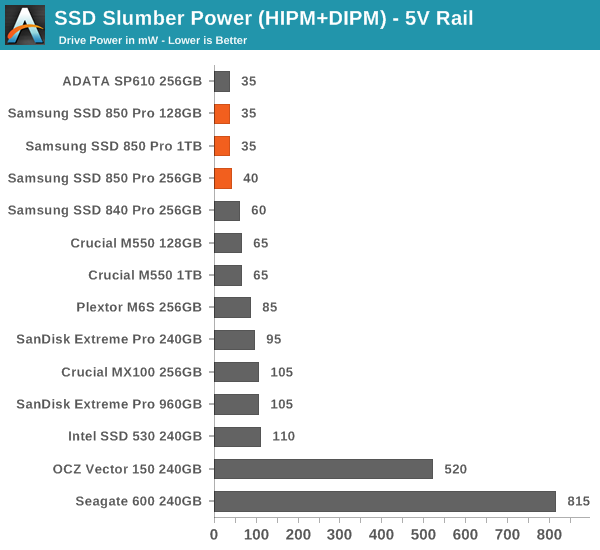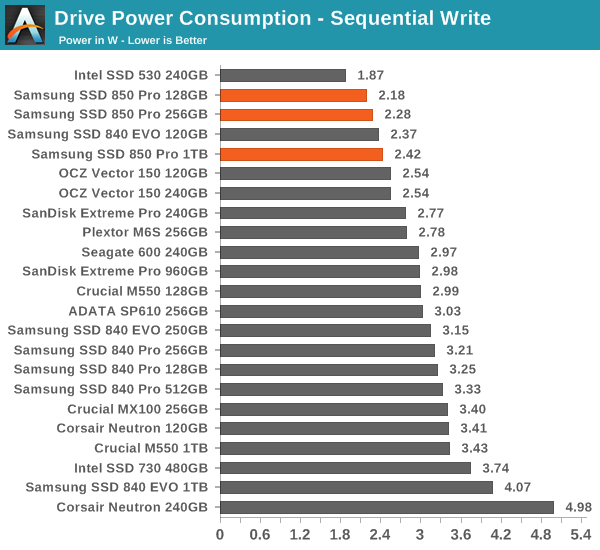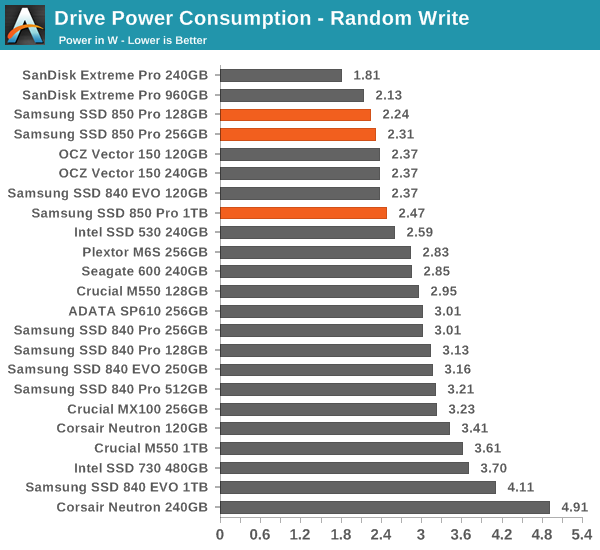Samsung SSD 850 Pro (128GB, 256GB & 1TB) Review: Enter the 3D Era
by Kristian Vättö on July 1, 2014 10:00 AM ESTPower Consumption
Samsung has always been pushing hard with power consumption and the 850 Pro is another proof of their efforts. Slumber power is down by a bit compared to the 840 Pro and generally speaking the 850 Pro is one of the most efficient drives. Even load power consumption stays at below 2.5W, which is superb given the performance of the 850 Pro.













160 Comments
View All Comments
Cerb - Tuesday, July 1, 2014 - link
The SSD just quitting could brick the drive, and could hose up the FS. Like ECC RAM, if you need power loss protection, you need it regardless of file system. IMO, they should all at least be equipped with enough to gracefully finish in-progress writes and shut down (not necessarily empty buffers, but set up a state that they can be guaranteed to be able to roll back from).sonicology - Tuesday, July 1, 2014 - link
Typo?"Scaling below 20nm was seemed as a major obstacle but the industry was able to cross that..."
seemed a major obstacle or seen as a major obstacle, but not seemed as a major obstacle
Bladen - Tuesday, July 1, 2014 - link
Is it just me, or does the "Performance Consistency" page have interactive charts, all of which are entitled "(SSD name and capacity) - 4KB Random Write (QD32) Performance", but with different results in each of the graphs for the same SSDs and capacities? Also, descriptive text is missing below the last two.I'm presuming they are supposed to be a read and another read or write one, presumably at a lower queue depth.
MrSpadge - Tuesday, July 1, 2014 - link
They're the same data in different scales.paesan - Tuesday, July 1, 2014 - link
I purchased a 512GB MX100 when they first came out for $199. No way the extra speed from the 850 pro is worth over twice the price as the MX100. Nobody is going to keep that drive for 10 years anyway. In 10 years the drive will be obsolete. Most users won't even notice the difference in speed in their every day usage.MrSpadge - Tuesday, July 1, 2014 - link
BTW: that image is surely not an X-Ray but "just" an ordinary SEM image (scanning electron microscope).Spatty - Tuesday, July 1, 2014 - link
This is correct. SEM image after a FIB.drwho9437 - Wednesday, July 2, 2014 - link
As I mentioned elsewhere, it is probably a STEM bright field image after a FIB liftout of the gate stack. Certainly not an X-ray; he should be correct the article...Cerb - Tuesday, July 1, 2014 - link
"The wear out causes the insulators to lose their insulating characters" - shouldn't that be characteristic(s)?jann5s - Tuesday, July 1, 2014 - link
I'm wondering If this technology will also end up in SD (XD) memory cards?